Zapier is an “automation platform.” If you look at this single phrase that defines its category, there is not much search demand: 200 monthly searches in the U.S. and around 1.1K globally. It doesn’t seem quite like a $144M ARR business opportunity. And judging by search demand, it’s not something you’ll promote with SEO.
Yet, Zapier’s blog alone brings 1.6M organic visits every month. That’s traffic worth about $3.7M and 67.5% of its overall organic traffic.
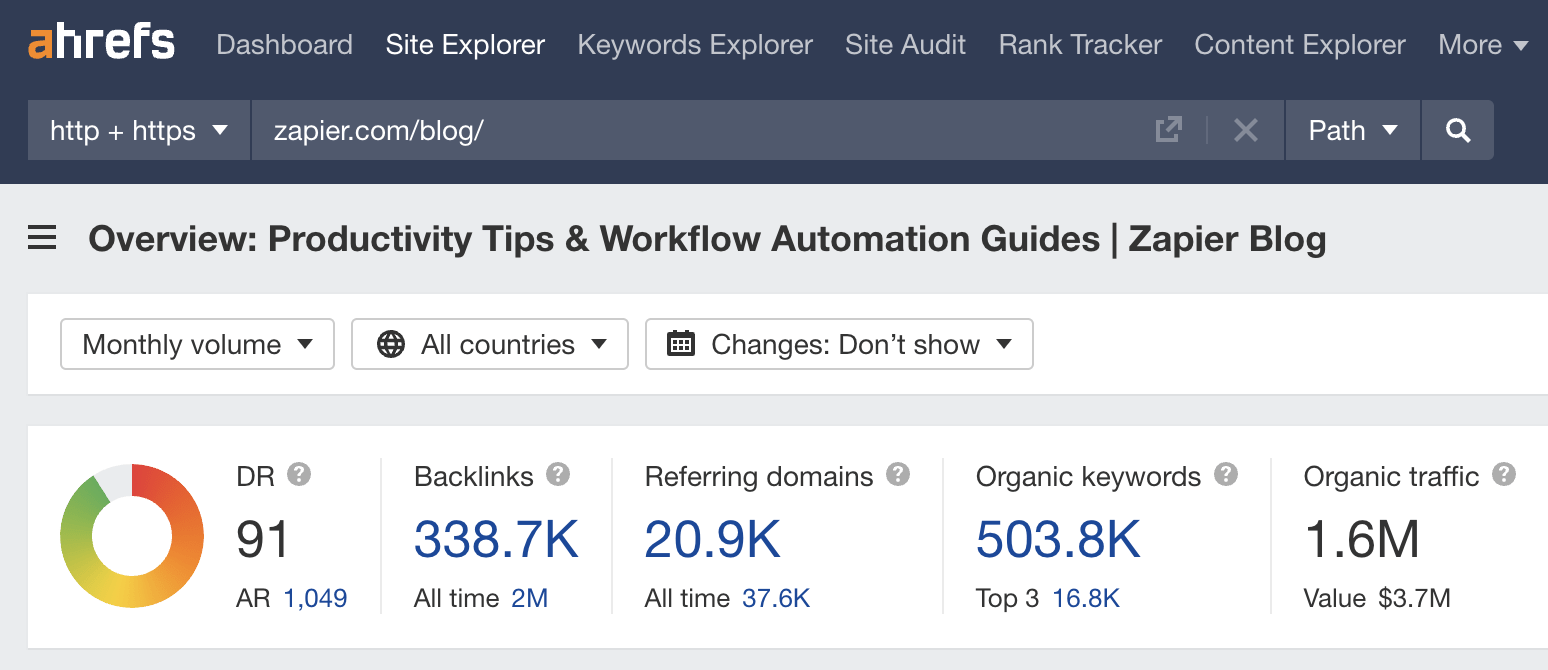
So let’s see why Zapier didn’t turn away from SEO and how it managed to make SEO work like a charm.
SEO is generally worth it if one of the following things is true:
- Potential customers are searching for what you sell or do.
- Potential customers are searching for solutions to problems your business helps to solve.
But there seems to be a third way. It’s when potential customers are searching for solutions you can improve upon or even disrupt. Zapier seems to follow this tactic exceptionally well.
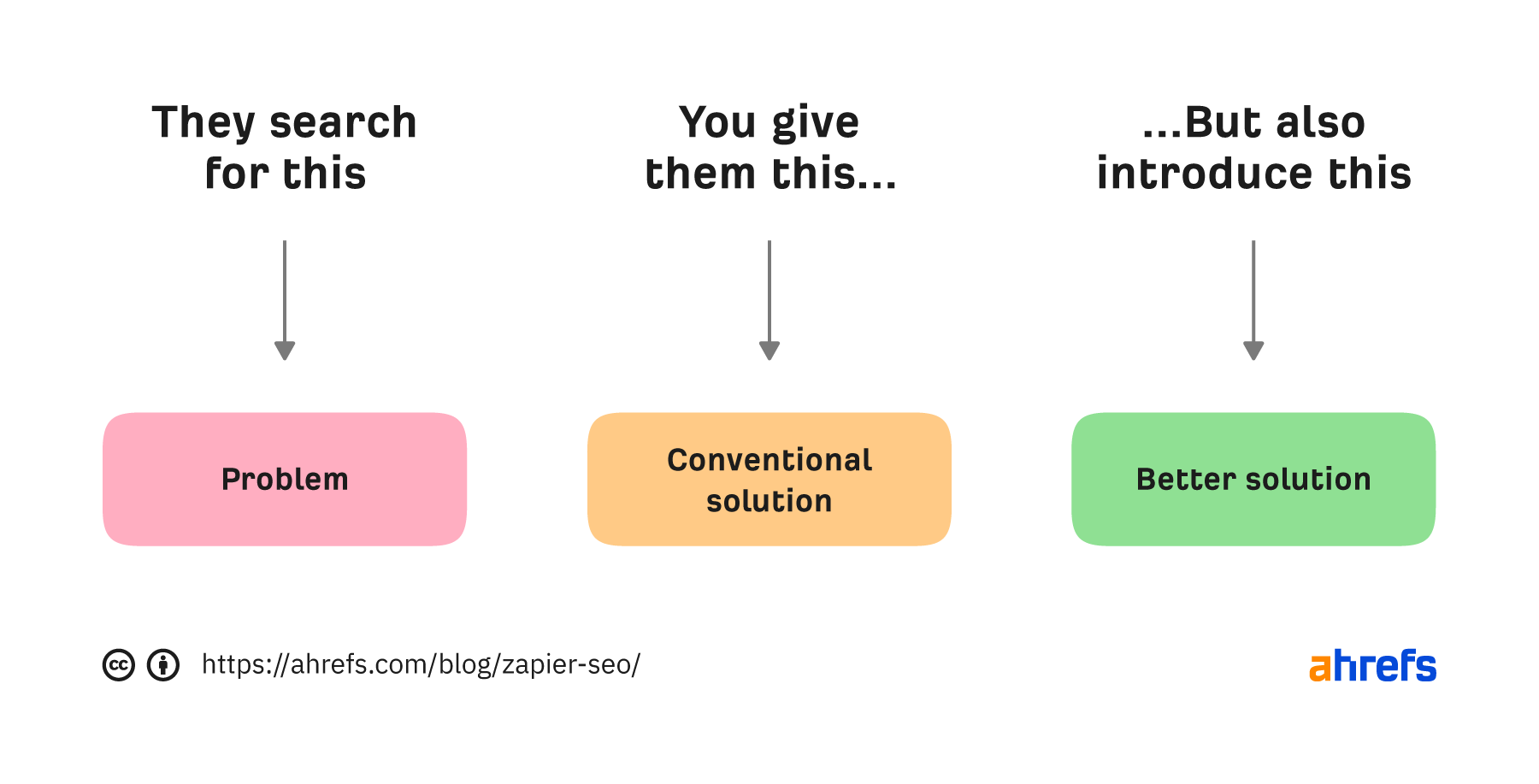
The whole concept reminds me of using a back door. Here’s an example. This article about “to-do list” apps can’t possibly talk about Zapier directly because Zapier is not that kind of app.

So instead, the article introduces the app through a series of “back doors.” Here’s back door #1:
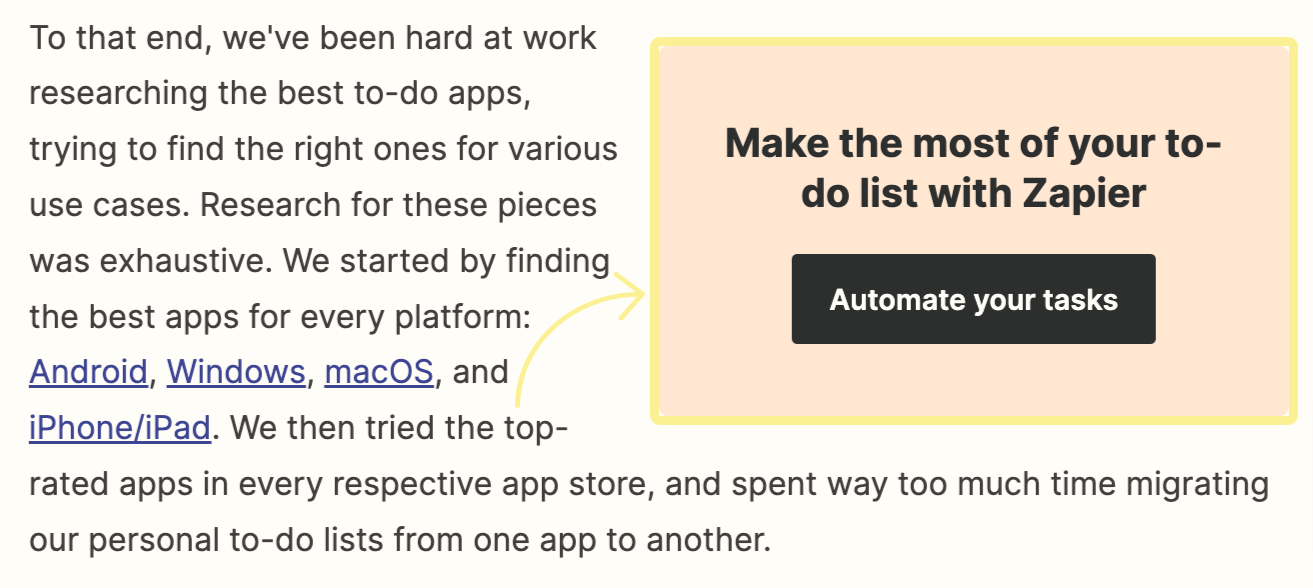
And back door #2:

There are even more back doors here leading to product marketing articles:
- Link to another blog post with more automation ideas
- Links to product landing pages explaining the entire integration with a given app (example)
- Link inside the “related reading” section
Why build these back doors? Because thanks to high-volume keywords and their long-tail…

… this one article gets 58.8K organic search visits monthly.

That’s a ton of traffic Zapier can channel to its money pages.
Add some more articles like that, and you’ve discovered the pattern behind the best-performing articles on Zapier’s blog.
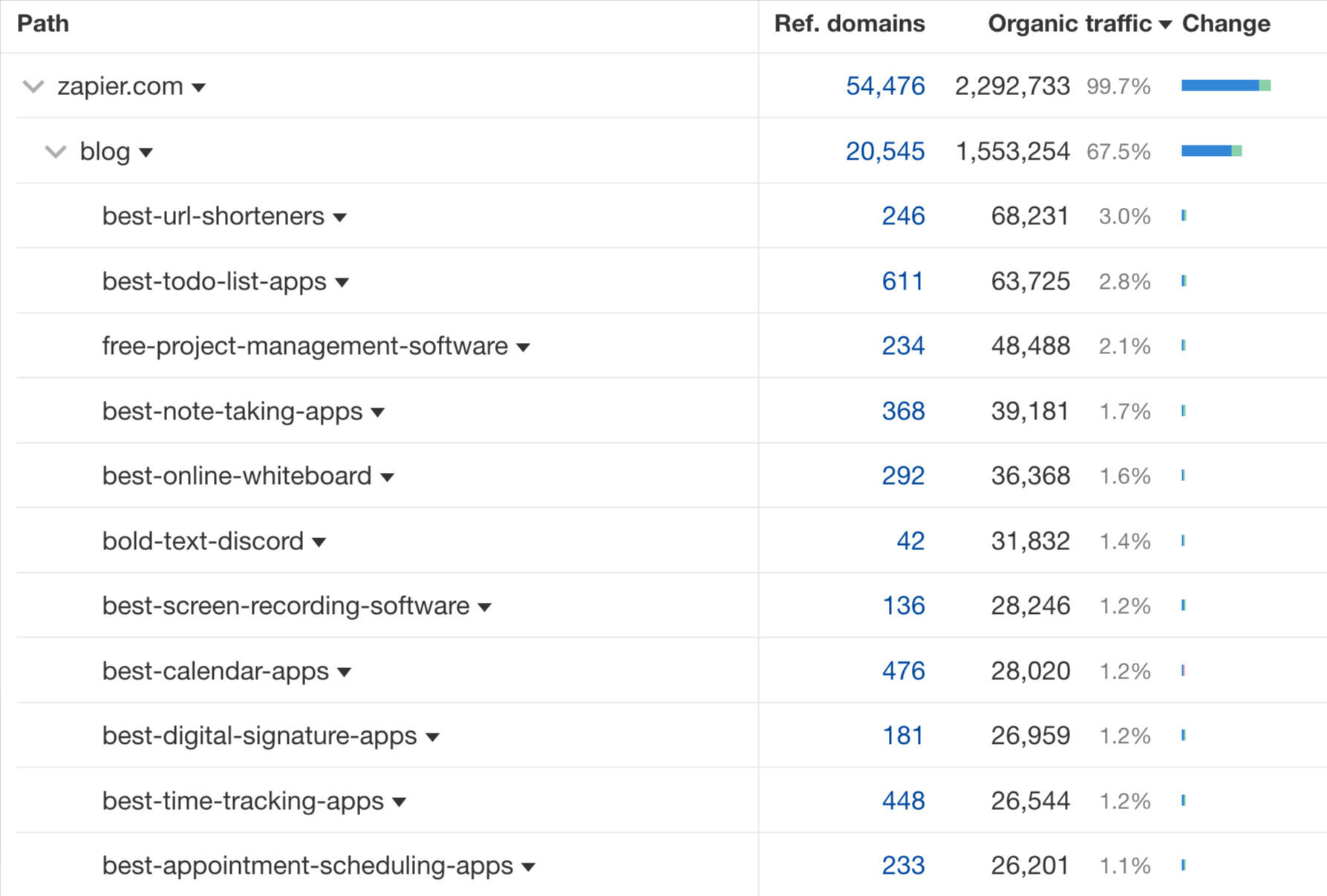
But not only is the organic traffic impressive here. Rankings are too. There are 2,397 keywords with the “best” pattern ranking in positions #1–3 in the U.S. alone.

There’s more. Some of those “best” articles earned backlinks from hundreds of referring domains, including high-DR ones.
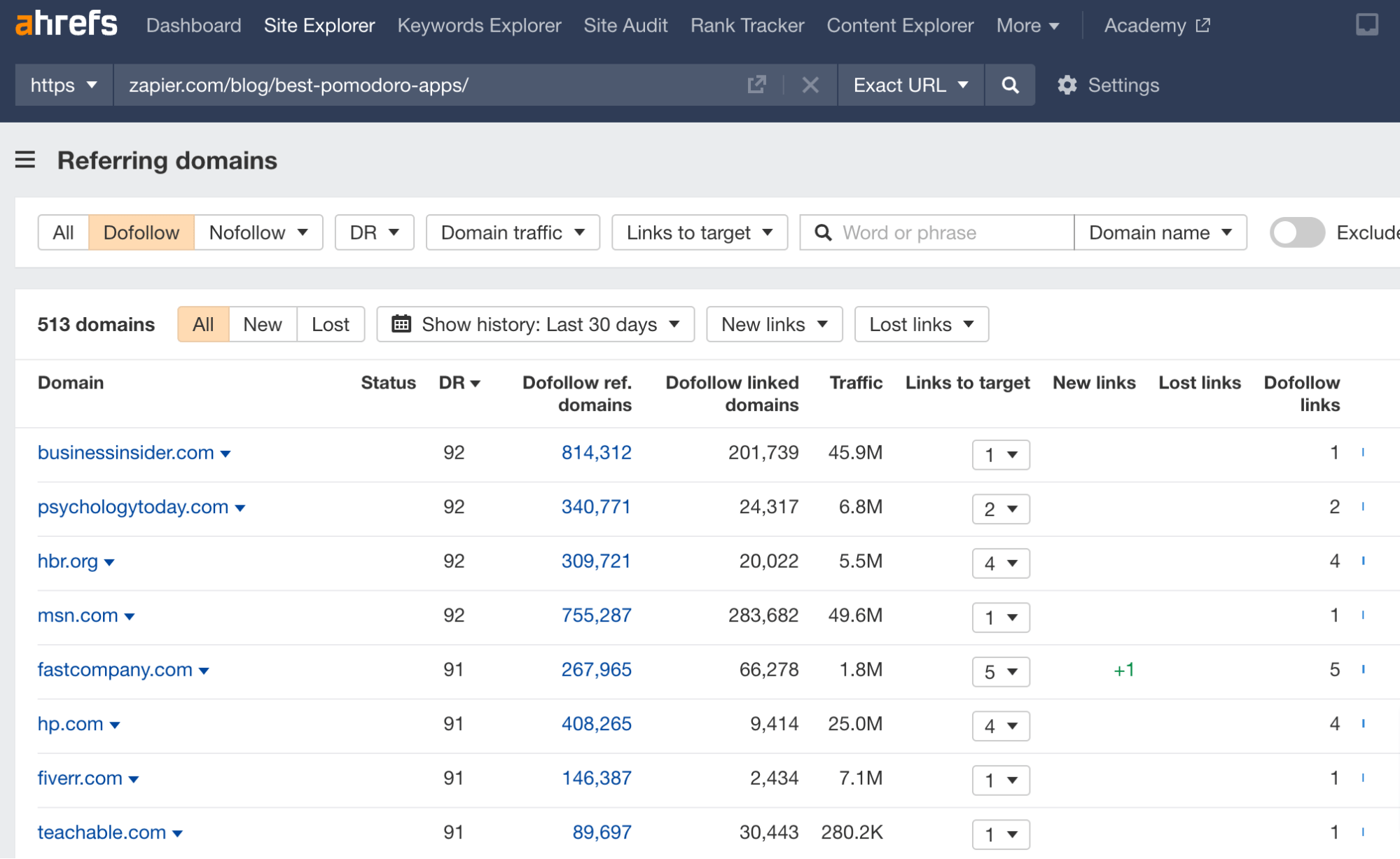
Takeaway
If you’ll like to replicate the “back door” tactic, the process can look something like this:
- Publish an article explaining a use case of your product
- Look for keywords with high search demand related to that use case
- Write an article directly targeting that high search volume keyword and insert a link to the article explaining the use case—that link is the back door
This way, searchers can get what they expect from an article directly targeting the broad keyword and then some more, thanks to your use case. Keep in mind, though, that some of those broader keywords can be tough to rank for.
There may be another approach to creating the back door. You can start from keyword research:
- Look for keywords with high search demand and are somehow related to your product
- See if your product can improve what people are searching for and write an article describing that use case (the back door)
- Write the article targeting the broad keyword and insert the back door inside the article
It may also be worth noting that this tactic is as good as the sign on the back door, i.e., the call to action. I mean, who wouldn’t want to automate their tasks for free?

Let’s take a look at the next biggest source of traffic after the blog.

So what are “apps”? That’s a bunch of product landing pages that get their traffic from pure demand for Zapier’s apps or features, right?
Not exactly. The main driver of traffic to those pages is demand for somebody else’s apps.
Zapier doesn’t simply list its apps. It lists other people’s app integrations with other people’s apps.
And if I’m not mistaken, we’re not necessarily talking about the demand that Zapier invented. We’re not talking about an out-of-the-blue invention like Metallica + Lady Gaga.

We’re talking about things that people all over the U.S. actually plug into Google because they need things like Dropbox and Google Drive integration in their lives.
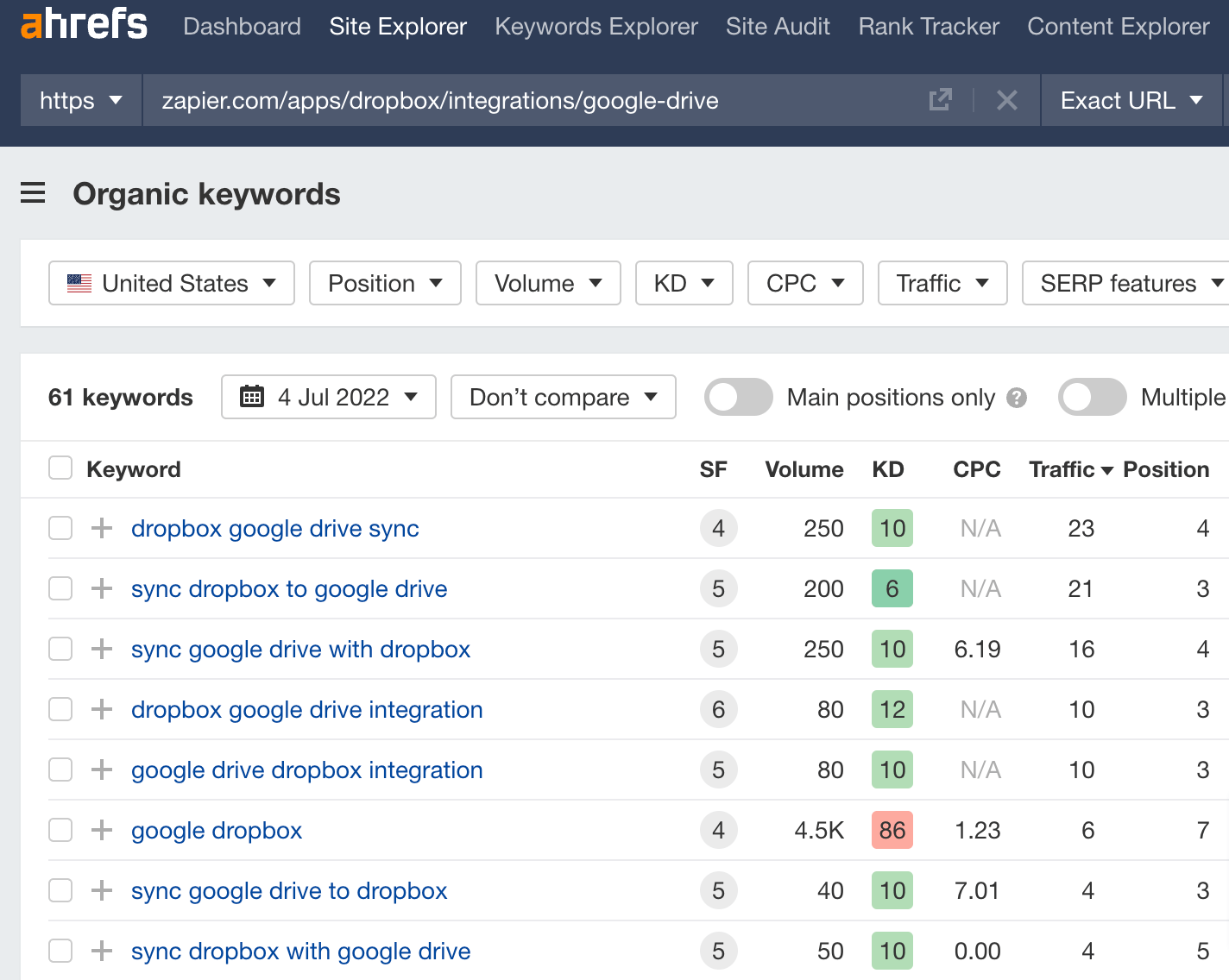
But why are we even talking about integrating Dropbox with Google Drive and not Dropbox and Zapier?
Here’s the thing. Zapier integrates with Dropbox, which can be integrated with YouTube, Gmail, Office 365, Notion, and tons of other apps. This means that Zapier integrates with the above apps too. On top of that, there are also three-way connections like Dropbox + Drive + Slack.
If that’s the actual functionality of the app and some of those connections have “impossible to ignore” search demand, then Zapier will need to create a landing page for each of those situations.
Guess what. That’s exactly what Zapier did. And it turned out beautifully, driving 16% of the entire organic traffic. Here are some of the top-performing integrations in terms of traffic.

Let’s see what’s inside that “apps folder.”
When you pick one of the apps, you get a landing page with a corresponding title, H1, and URL.

Then you add another app to the mix. Again, a landing page with custom H1 and URL.

But what if the customer wants to connect Google Sheets, Trello, AND Slack? This calls for another landing page (just one more connection before turning into a Rube Goldberg machine).
Perfect. However, the longer that “train” gets, the fewer keywords the consequent “wagons” rank for. The first page from the above gets an estimated 1.9K organic visits while ranking for 444 keywords. But the last page (Sheets-Trello-Slack) gets no organic traffic.

The way you create tens of thousands of landing pages within one lifetime appears to be programmatic SEO and Zapier Partner Program.
Thanks to programmatic SEO, Zapier was able to generate the pages instead of manually creating them. While the “human touch” quality of inserting unique content into each of those pages was provided by allowing owners of the apps to write it.
Recommendation
Before:
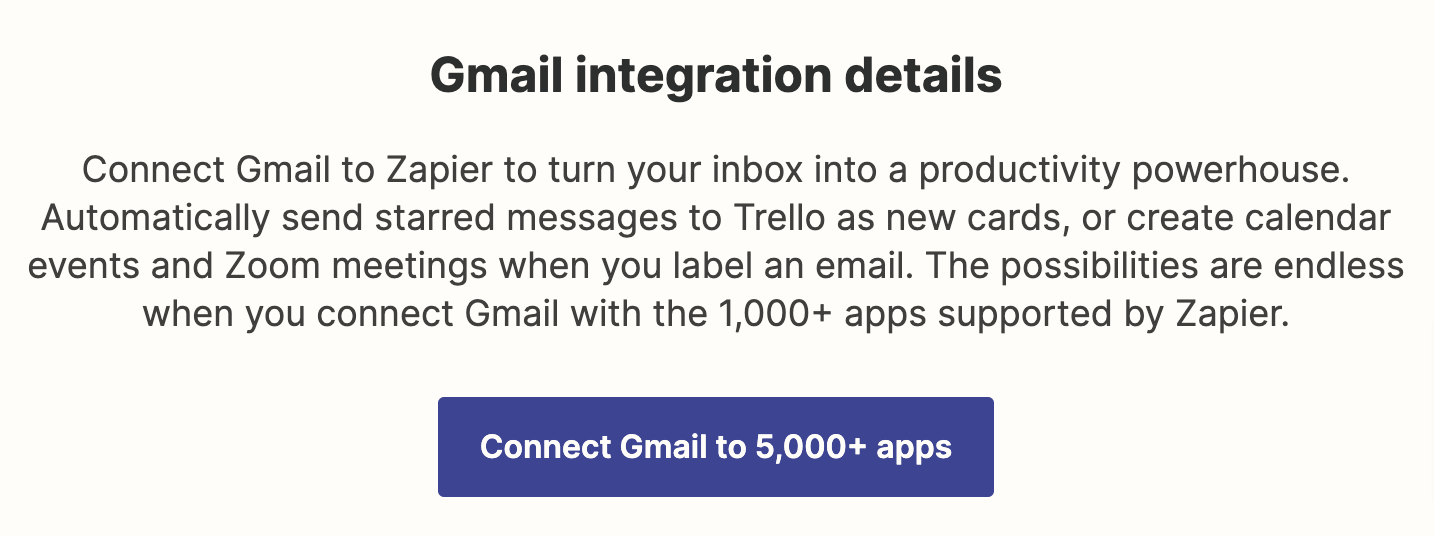
After:
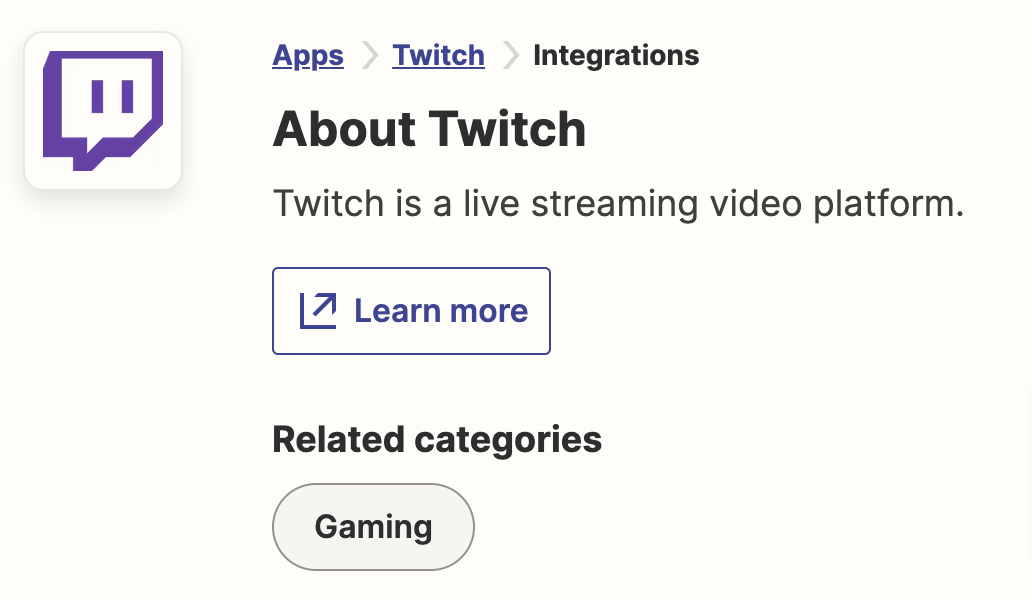
Check out Ryan’s case study to learn more about the effects of the programmatic approach over time. (Ryan started analyzing Zapier in 2018.) And while we’re at other Zapier case studies, this is also an interesting one by Jessica Greene: Does Updating Website Content Work? [Zapier Case Study].
Zapier uses this kind of landing pages to leverage branded search too.
Keyword research for “zapier” shows over 25K results in the U.S. And that list is full of branded keywords like these:

Most, if not all, of those keywords already have corresponding programmatically generated landing pages.
By the way, I won’t be surprised if it uses keyword research for market research. It can just see what people plug in Google to invite new partners or build new features.
Takeaway
There are probably multiple takeaways here. But the main one is search intent, if you ask me.
Zapier’s app landing pages get so much traffic from other people’s branded keywords because those pages align with search intent flawlessly.
If you look at the SERP for “google sheet integrations,” there are hardly any content types different from a product landing page. So the investment in devising a system to generate all of those app landing pages seems to work really well. Good thing Zapier didn’t try to target those with how-to blog posts. Blog posts likely don’t stand a chance here.

By the way, I find it fascinating that its Google Sheets integrations landing page ranks at #12 for simply “google sheets.”

I wonder if there’s anything SEO-wise it can do to jump back to the top 10 like in 2018.

What I call a self-building content hub (aka topic cluster) is a situation where you organize your existing content into a content hub structure and link new related content (subpages) as you create it.
Using this strategy, you can commit to creating more content only if the subpages make sense themselves. In other words, you don’t need to take big risks investing in creating or expanding a content hub.
Let’s look at the big picture to give this more context.
Some content marketers build topic clusters in a set-and-forget approach. You see an opportunity, design a topic cluster, build it, and that’s it. You never or hardly ever come back to it.
Nothing wrong with that.
But here’s the thing. If you continue to create more content on the same topic, that means that the initial cluster has been expanding all along. And a bigger topic cluster is usually a better topic cluster because it’s more comprehensive. All you need to do is to make the connection like Zapier does.
To illustrate, we’ve got this guide (a topic cluster, technically speaking) on remote work. In 2017, it was a set of 14 links. It contained only content developed specially for that hub.
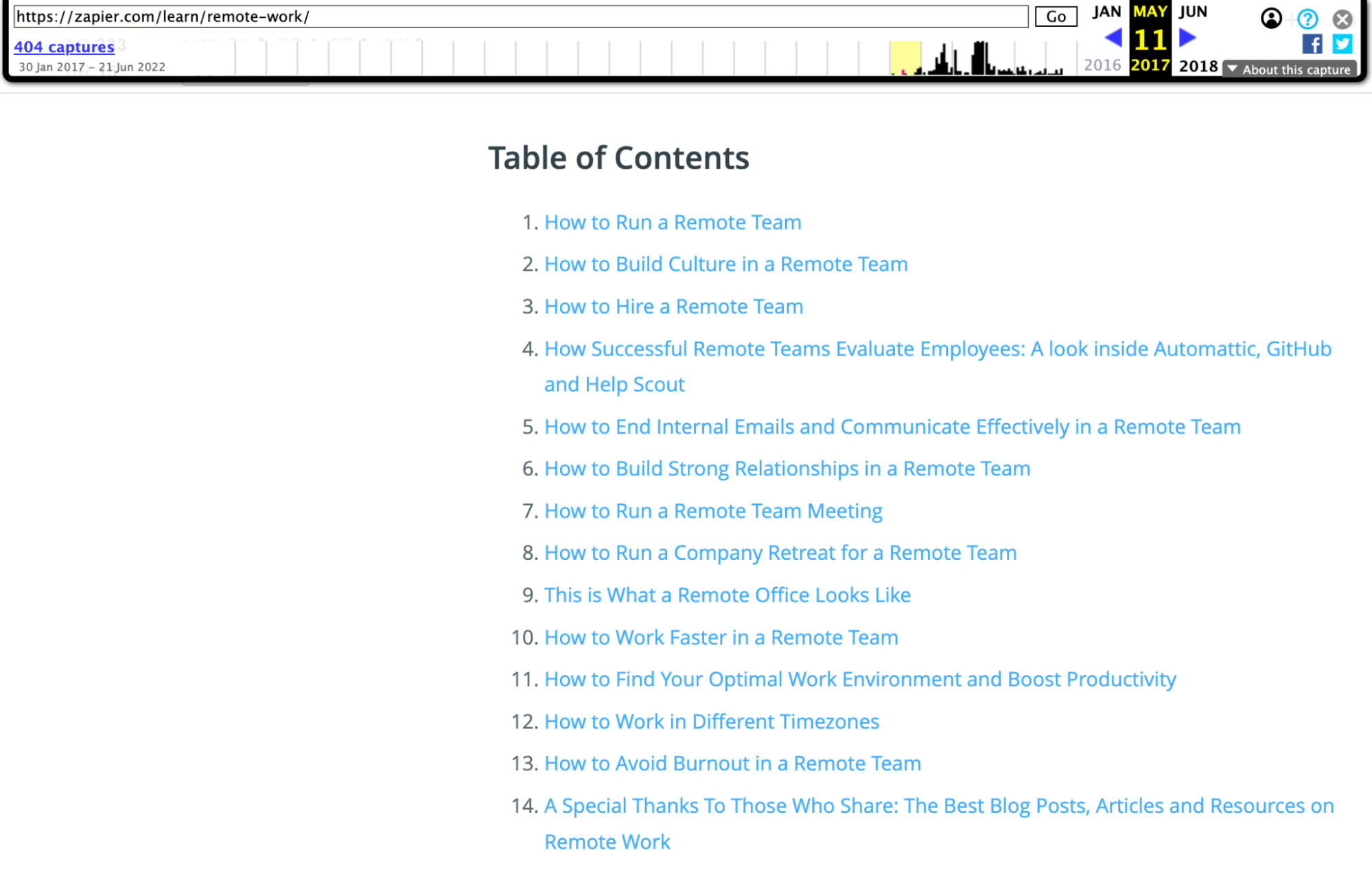
But Zapier hasn’t stopped publishing more stuff about remote work. It’s been busy with creating more guides, listicles, videos, case studies, and reports.
So it’s included links to all of that new content in the hub. And right now, some five years later, that list of 14 links has grown to over 50 links and some embedded videos. All of them organized into seven categories, plus the initial guide from 2017.

But why create a content hub in the first place?
So let’s imagine it hadn’t created that cluster at all. Then it wouldn’t have amassed 4.4K backlinks from 1.1K domains to date. Nor would it have reached the point of 1.1K organic traffic every month to that single page. And that’s on top of the results that each of the linked subpages gets.

And like I said, Zapier doesn’t need to create more content for the hub. As it creates content, it can simply link subpages that make sense to the hub.

What if it hadn’t added all of those additional links to the cluster? That’s a tougher question to answer. But I guess that is part of the reason why referring domains to the pillar page keep growing steadily over the years. After all, adding more helpful content should make the hub more attractive, hence link-worthy.
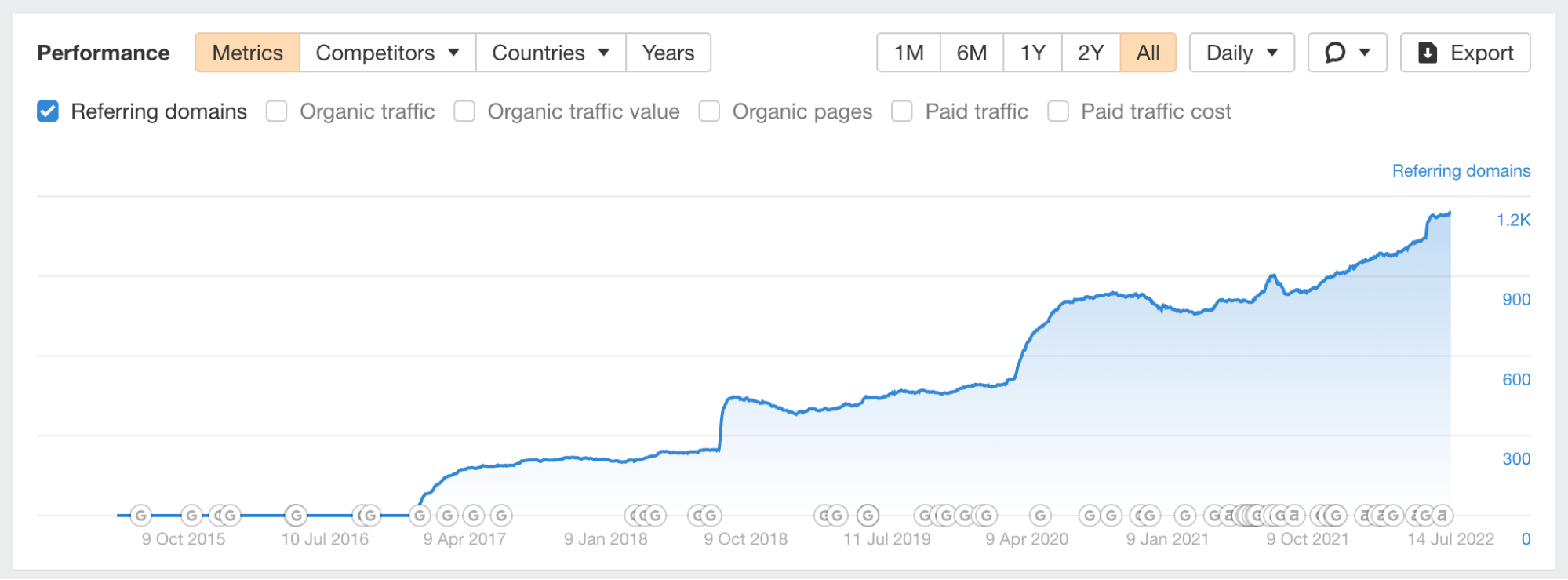
Let’s not forget those links are, in fact, internal links that distribute link equity from the pillar page to the linked pages.
All in all, the whole structure of this topic cluster reinforces itself. More content makes the topic cluster more helpful and link-worthy. And when the pillar page gets backlinks, it “gives back” to the linked content by distributing link equity.
Takeaway
Simply put, consider creating a content hub utilizing your existing content. You can then expand it with new subpages only if they make sense themselves.
Have a content hub already? See if there is any additional content you can link to on the pillar page.
Of course, creating a content hub from scratch is still a good idea. That’s what Zapier initially did and then expanded. As we can see from its results, it creates a new “entity” able to generate backlinks and traffic on its own.
Original research makes great link bait.
But what makes original research good enough to make people link?
This Zapier research shows that it’s not necessarily about the length of the study.
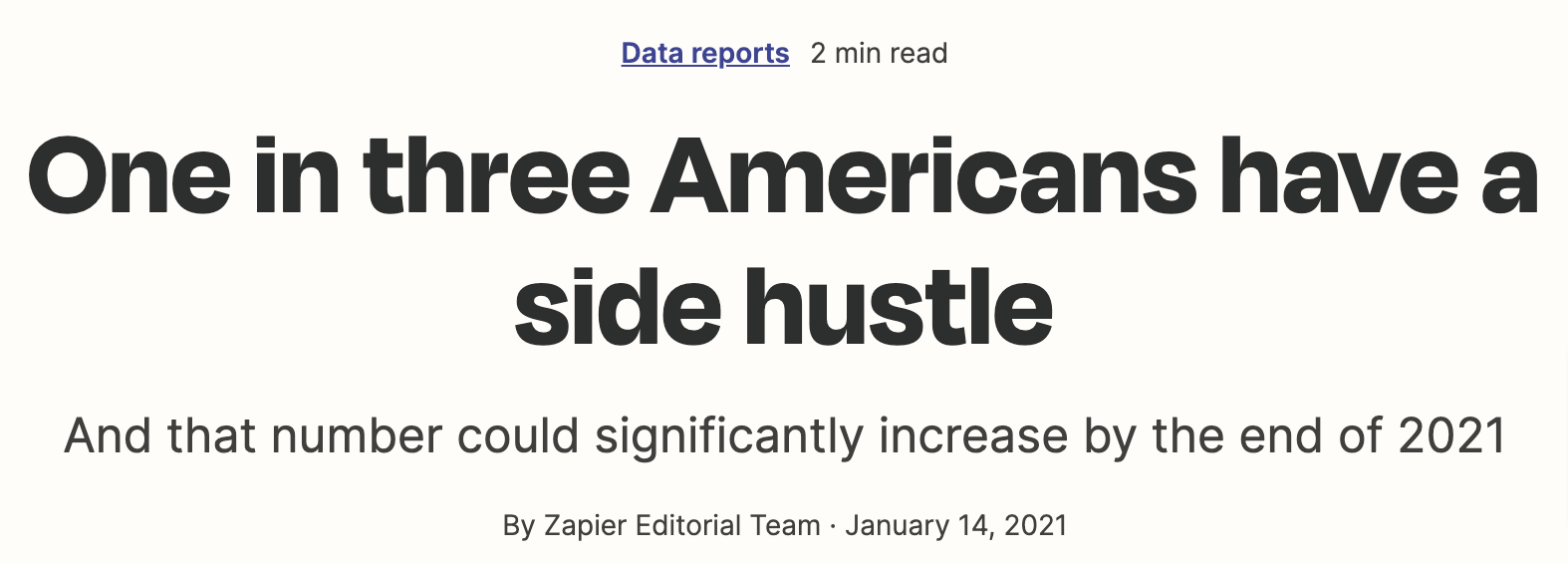
Excuse me while I use a completely made-up metric. But just to show how “efficient” that link bait is, there are 1.5 domains linking to that page per every word used to describe it. That’s including the title and the methodology note.
But are the linking domains any good?
Here are some of the +90 DR domains linking to this 637-word research, along with their traffic:
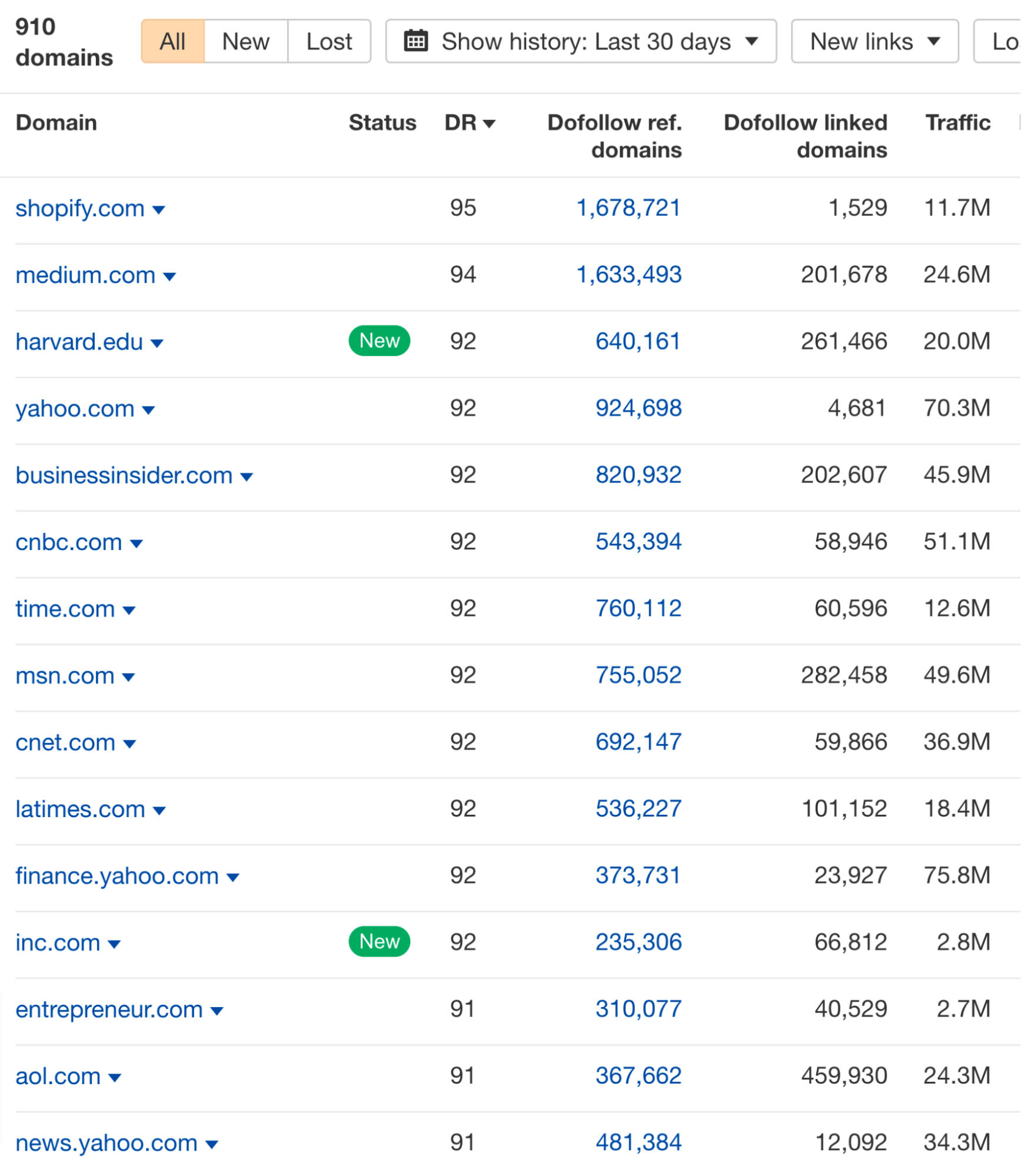
I think this bite-sized research is so powerful because:
- It answers a really well-posed question: How many Americans had a side hustle?
- Side hustles are a sign of the times.
- The research gets right to the point. It starts with the most important thing (the answer).
- There are graphics that tell the story, just waiting to be shared by linkers.
- After all of that goodness, I don’t think anybody has any problems with the study content including a soft PR pitch of Zapier and a few relevant links to its content. Naturally, those links help to distribute link equity.
Takeaway
Original research can get you hundreds or even thousands of links. But doing that is no small feat.
However, Zapier shows that this kind of content doesn’t have to be long to get a ton of links. You don’t even need to do it yourself (Zapier outsourced its own).
Just make your research timely, important to your target audience and/or the audience you want to pitch to, and get right to the point.
Some “auto promotion” here and there likely won’t be frowned upon. But first, give people what they came for.
Oh, and don’t worry if your report won’t take off on social media.
Remember that one of the reasons people use social media is entertainment. Even LinkedIn.

What struck me about Zapier’s SEO is how everything is densely interlinked.
We’ve got:
- Links inside the blog posts to other content and product features.
- Links inside content hubs.
- Links from original reports.
- Links as breadcrumbs in the app directory.
- Links to selected content on the homepage.

And it matters because internal links help pages rank higher. Google utilizes internal links to:
- Discover new pages.
- Pass link equity between pages.
- Understand what a page is about.
Takeaway
Use pages with a lot of backlinks to boost other pages. You can boost your “boring” money pages with link equity from pages with a lot of backlinks. This is called the middleman method.
But keep in mind these two caveats to using internal links:
- Theoretically, the more links you have on the page, the more they will compete with each other for clicks and “dilute” the authority transferred to other pages. So just watch out for “spamming” your pages with internal links.
- Too many internal links, especially inside the content of an article, can lead to poorer UX.
If Zapier is so good at SEO, why does it create content that gets little-to-no search traffic? Sometimes, those articles don’t even have any kind of search demand.
And why are they so… unrelated? Examples:
- Don’t work more when you work from home.
- How to be a good co-worker to your pets.
- Why I replaced my morning coffee with a cup of warm water.
- What a giant pile of laundry taught me about productivity.
- How a mid-day walk changed my energy levels—at work and at home.
Clearly, these articles haven’t been created for SEO reasons…
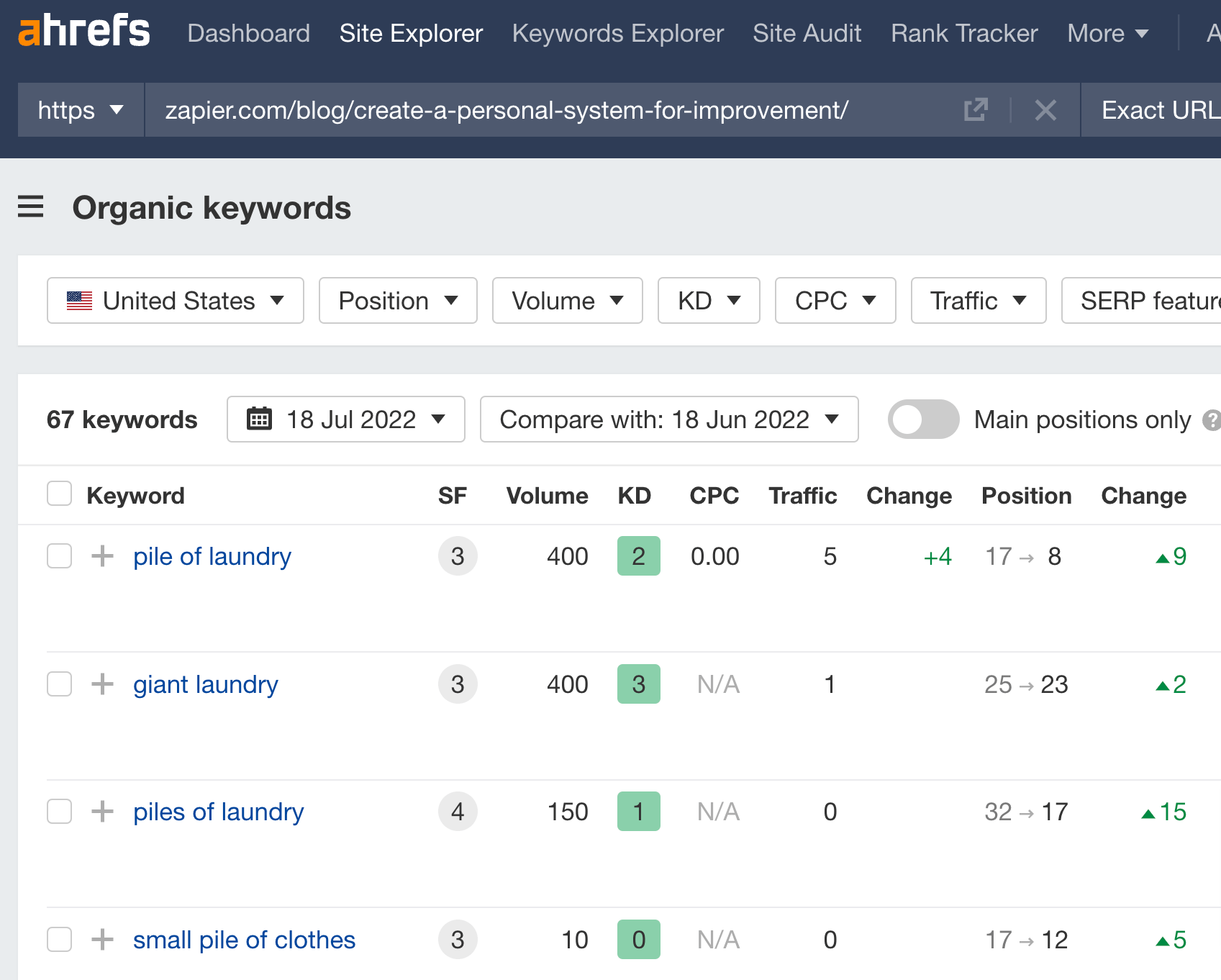
By no means is this an attempt to troll Zapier. I get it. All of the above titles are certainly an interesting read for people concerned about productivity and well-being.
My point is that while Zapier is great in SEO, it doesn’t make its content marketing only about ranking for keywords with traffic potential.
When you tie only SEO goals to your content marketing, you risk creating an operations-centric approach instead of a customer-centric approach.
A customer-centric approach is when you know certain topics interest your audience, so you pursue them. Even if they have 0 search volume and you won’t rank in a million years. But hey, your audience will still appreciate your effort.
One condition, though: You need to have a way to communicate with your audience directly, such as a newsletter.

Takeaway
When you’re great at SEO content, there is a temptation to focus only on SEO content that “converts.” It’s good to know where to draw the line.
If you’re trying to nurture an audience, develop a relationship with them, make them read every newsletter you send them, and make them trust and recommend your blog, then maybe it’s a good idea to take a step back and think outside of keyword research.
So if you have an opportunity to publish an interesting article that won’t necessarily bring you organic traffic, it still may be worth it if you can promote it via your direct marketing channels.
Final thoughts
I’ve heard a couple of times from different marketers that they don’t pursue SEO because they are in “a new niche with no search demand yet.” I think Zapier’s case shows that if you dig a little deeper, you may hit a motherload of SEO opportunities. But you may need to enter through the “back door.”
After all, theoretically, there must be some kind of market demand that you’re building your product on. And if there’s market demand, you will likely find search demand.
Got questions or comments? Ping me on Twitter.
